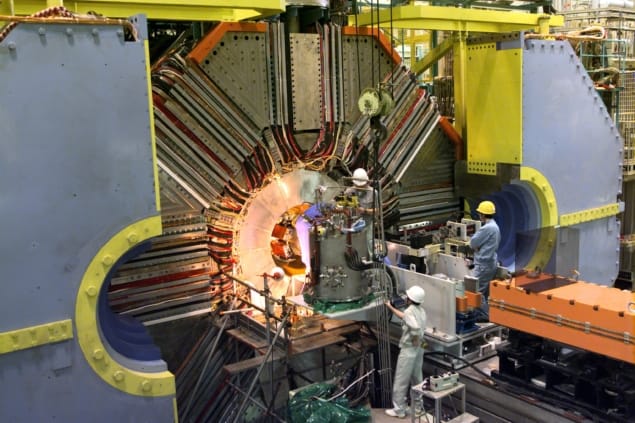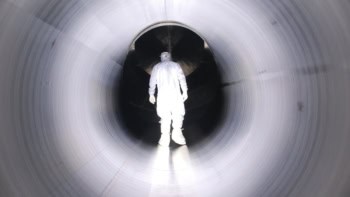
The first electron–positron collisions occurred at an upgrade to one of Japan’s premier particle-physics experiments on 26 April. Following six years of work, the start of the SuperKEKB accelerator heralds a new era of particle physics at the KEK particle-physics lab in Tsukuba.
SuperKEKB is a ¥29bn ($370m) upgrade of the 3 km circumference KEKB collider, which consists of two circular accelerators – one carrying electrons and the other positrons. KEKB shut down in 2011 for construction to start on SuperKEKB, which involved upgrading the beam-pipes to allow SuperKEKB to produce electrons with an energy of 7 GeV, while the positron beam has an energy of 4 GeV.
More B mesons
The current of the electron ring has also been ramped up from 1.2 A to 2.6 A, with the positron ring boosted from 1.6 A to 3.6 A to increase the number of collision events by a factor of 40 over KEKB. The beam “spot” will be just 50 nm high at the collision point. The upgraded accelerator is designed to pump out large numbers of B mesons (around 50 billion pairs) as well as other particles such as D mesons and tau leptons that could shed further light on why the universe contains more matter than antimatter.
The original KEKB facility included a detector called Belle that allowed physicists to study the remnants of the particle collisions. It has also been upgraded, and the renamed Belle II can handle the huge increase in the collision rate and survive the radiation damage caused by the flux. Key to this design is the inner vertex detector, which has four layers of conventional silicon strips as well as two layers of pixel detectors made from a depleted P-channel field effect transistor (DEPFET). This material, it is hoped, should make the detector better at pinpointing where particles decay.
“Belle II is a unique universal spectrometer with full capabilities for detecting charged particles, photons and neutrinos with high efficiency,” Belle II’s Thomas Browder from the University of Hawaii told Physics World. “This will allow unprecedented sensitivity to the full range of new physics in the ‘flavour sector’”.
Further difficulties
Collisions will now run for six months to refine the accelerator and detector. KEK director general Masanori Yamauchi says: “Though there will be further difficulties that we must face before the SuperKEKB accelerator achieves its design luminosity, 40 times higher than KEKB’s world record, KEK will strive towards success in research together with many collaborators from all over the world”.
The vertex detector will be installed in Belle II by January 2019, with the full physics programme starting a month after that.



